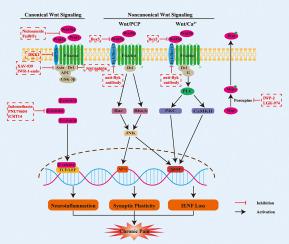Pharmacology & Therapeutics ( IF 12.0 ) Pub Date : 2021-09-02 , DOI: 10.1016/j.pharmthera.2021.107984 Ya-Qun Zhou 1 , Xue-Bi Tian 1 , Yu-Ke Tian 1 , Wei Mei 1 , Dai-Qiang Liu 1 , Da-Wei Ye 2

|
Despite the rapid advance over the past decades to design effective therapeutic pharmacological interventions, chronic pain remains to be an unresolved healthcare concern. Long term use of opioids, the first line analgesics, often causes detrimental side effects. Therefore, a profound understanding of the mechanisms underlying the development and maintenance of chronic pain states is urgently needed for the management of chronic pain. Substantial evidence indicates aberrant activation of Wnt signaling pathways in sciatic nerve, dorsal root ganglia and spinal cord dorsal horn in rodent models of chronic pain. Moreover, growing evidence shows that pharmacological blockage of aberrant activation of Wnt signaling pathways attenuates pain behaviors in animal models of chronic pain. Importantly, both intrathecal injection of Wnt agonists and Wnt ligands to naïve rats lead to the development of mechanical allodynia, which was inhibited by Wnt inhibitors. In this review, we summarized and discussed the therapeutic potential of pharmacological inhibitors of Wnt signaling in chronic pain in preclinical studies. These evidence showed that aberrant activation of Wnt signaling pathways contributed to chronic pain via enhancing neuroinflammation, regulating synaptic plasticity and reducing intraepidermal nerve fiber density. However, these findings raise further questions. Overall, despite the future challenges, these pioneering studies suggest that Wnt signaling is a promising therapeutic target for chronic pain.
中文翻译:

Wnt 信号:慢性疼痛的前瞻性治疗靶点
尽管过去几十年来设计有效的治疗药物干预措施取得了快速进展,但慢性疼痛仍然是一个未解决的医疗保健问题。长期使用阿片类药物(一线镇痛剂)通常会导致有害的副作用。因此,对于慢性疼痛的管理,迫切需要深入了解慢性疼痛状态发展和维持的机制。大量证据表明,在慢性疼痛的啮齿动物模型中,坐骨神经、背根神经节和脊髓背角的 Wnt 信号通路异常激活。此外,越来越多的证据表明,Wnt 信号通路异常激活的药理学阻断可减轻慢性疼痛动物模型中的疼痛行为。重要的,对幼稚大鼠鞘内注射 Wnt 激动剂和 Wnt 配体都会导致机械异常性疼痛的发展,而这种异常性疼痛被 Wnt 抑制剂抑制。在这篇综述中,我们总结并讨论了 Wnt 信号通路药物抑制剂在临床前研究中对慢性疼痛的治疗潜力。这些证据表明,Wnt 信号通路的异常激活通过增强神经炎症、调节突触可塑性和降低表皮内神经纤维密度而导致慢性疼痛。然而,这些发现提出了进一步的问题。总体而言,尽管未来面临挑战,但这些开创性研究表明,Wnt 信号传导是治疗慢性疼痛的有希望的靶点。我们在临床前研究中总结并讨论了 Wnt 信号通路药物抑制剂在慢性疼痛中的治疗潜力。这些证据表明,Wnt 信号通路的异常激活通过增强神经炎症、调节突触可塑性和降低表皮内神经纤维密度而导致慢性疼痛。然而,这些发现提出了进一步的问题。总体而言,尽管未来面临挑战,但这些开创性研究表明,Wnt 信号传导是治疗慢性疼痛的有希望的靶点。我们在临床前研究中总结并讨论了 Wnt 信号通路药物抑制剂在慢性疼痛中的治疗潜力。这些证据表明,Wnt 信号通路的异常激活通过增强神经炎症、调节突触可塑性和降低表皮内神经纤维密度而导致慢性疼痛。然而,这些发现提出了进一步的问题。总体而言,尽管未来面临挑战,但这些开创性研究表明,Wnt 信号传导是治疗慢性疼痛的有希望的靶点。调节突触可塑性和降低表皮内神经纤维密度。然而,这些发现提出了进一步的问题。总体而言,尽管未来面临挑战,但这些开创性研究表明,Wnt 信号传导是治疗慢性疼痛的有希望的靶点。调节突触可塑性和降低表皮内神经纤维密度。然而,这些发现提出了进一步的问题。总体而言,尽管未来面临挑战,但这些开创性研究表明,Wnt 信号传导是治疗慢性疼痛的有希望的靶点。











































 京公网安备 11010802027423号
京公网安备 11010802027423号